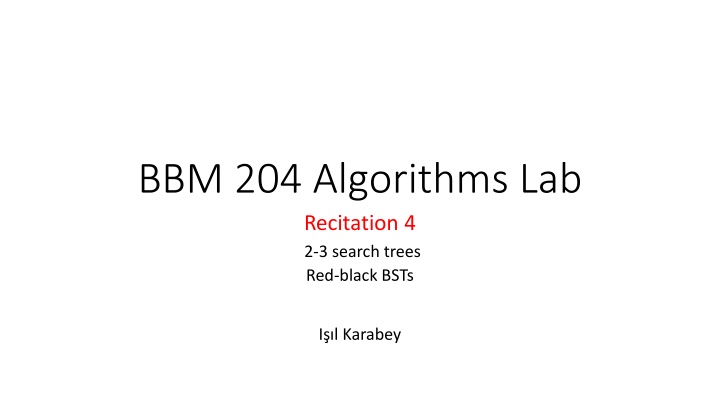
Balanced Search Trees and 2-3 Trees for Efficient Data Operations
Discover the significance of balanced search trees and 2-3 trees in optimizing search, insertion, and removal operations. Dive into exercises and illustrations to enhance your understanding of these data structures.
Download Presentation

Please find below an Image/Link to download the presentation.
The content on the website is provided AS IS for your information and personal use only. It may not be sold, licensed, or shared on other websites without obtaining consent from the author. If you encounter any issues during the download, it is possible that the publisher has removed the file from their server.
You are allowed to download the files provided on this website for personal or commercial use, subject to the condition that they are used lawfully. All files are the property of their respective owners.
The content on the website is provided AS IS for your information and personal use only. It may not be sold, licensed, or shared on other websites without obtaining consent from the author.
E N D
Presentation Transcript
BBM 204 Algorithms Lab Recitation 4 2-3 search trees Red-black BSTs I l Karabey
Index Balanced Search Trees 2-3 search trees Red-black BSTs Exercises for 2-3 and Red-black trees
Why do we need a balanced tree? Source: http://ee.usc.edu/~redekopp/cs104/slides/L19_BalancedBST_23.pdf
2-3 Search Trees Each internal node has either 2 or 3 children All leaves are at the same level Find, insert and remove operations take O(logn) time Source: http://ee.usc.edu/~redekopp/cs104/slides/L19_BalancedBST_23.pdf
2-3 Search Trees Source: http://ee.usc.edu/~redekopp/cs104/slides/L19_BalancedBST_23.pdf
Exercise-1: 2-3 Insertion Draw the 2-3 tree that results when you insert the keys E A S Y Q U T I O N in that order into an initially empty tree Source: Algorithms, 4th Edition, R. Sedgewick and K. Wayne, Addison-Wesley Professional, 2011 (Chapter 3, Exercises 3.3.1, pp. 449)
Exercise-2 (Your turn ) Draw the 2-3 tree that results when you insert the keys Y L P M X H C R A E S in that order into an initially empty tree Source: Algorithms, 4th Edition, R. Sedgewick and K. Wayne, Addison-Wesley Professional, 2011 (Chapter 3, Exercises 3.3.2, pp. 449)
2-3 Search Tree Removal Source: http://ee.usc.edu/~redekopp/cs104/slides/L19_BalancedBST_23.pdf
Remove cases of 2-3 Trees Source: http://ee.usc.edu/~redekopp/cs104/slides/L19_BalancedBST_23.pdf
Remove Exercise 1 Source: http://ee.usc.edu/~redekopp/cs104/slides/L19_BalancedBST_23.pdf
Remove Exercise 1 (cont.) Source: http://ee.usc.edu/~redekopp/cs104/slides/L19_BalancedBST_23.pdf
Remove Exercise 2 Source: http://ee.usc.edu/~redekopp/cs104/slides/L19_BalancedBST_23.pdf
Red-black BSTs Every node is either red or black. If a node has a NULL child, that "child" is considered black If a node is red, then both of its children are black Every simple path from a node to a descendant NULL child has the same number of black nodes, (including the black NULL child) The root is black Source: http://web.cs.hacettepe.edu.tr/~sever/bil367/lectures/redblack16.pdf
Relation between Red-black BSTs and 2-3 tree Source: http://web.cs.hacettepe.edu.tr/~bbm202/slides/09-balanced-trees.pdf
Insertion Cases for Red-black BSTs Case 1: Right child red, left child black rotate left Case 2: Left child, left-left grandchild red rotate right Case 3: Both children red flip colors Source: http://web.cs.hacettepe.edu.tr/~bbm202/slides/09-balanced-trees.pdf
Exercise-3: Red-black BSTs Insertion Draw red-black BST that results when you insert the keys E A S Y Q U T I O N in that order into an initially empty tree Source: Algorithms, 4th Edition, R. Sedgewick and K. Wayne, Addison-Wesley Professional, 2011 (Chapter 3, Exercises 3.3.10, pp. 449)
Exercise-4 (Your turn ) Draw red-black BST that results when you insert the keys Y L P M X H C R A E S in that order into an initially empty tree Source: Algorithms, 4th Edition, R. Sedgewick and K. Wayne, Addison-Wesley Professional, 2011 (Chapter 3, Exercises 3.3.11, pp. 449)
